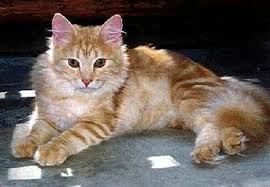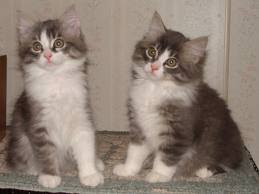The Siberian is really a domestic cat breed that has been present in Russia for centuries. The full name of the cat will be the 'Siberian Forest Cat' while often referred to as the 'Siberian' or the 'Siberian Cat'. The cat is an ancient breed which is now believed to be ancestral to all modern long-haired cats.The cat has similarities using the Norwegian Forest Cat, to which it really is most likely closely related.It is a natural breed as well as the national cat of Siberia.
 |
| Siberian Cat |
There are actually claims that it really is hypoallergenic and produces less Fel d1 than other cat breeds.
History
The cat was very first mentioned in a book by Harrison Wier, which included data of the earliest cat shows in England in 1871.The cat was initially imported to the United States in 1990 and, despite the recognition, the breed is rare within the US. The cat was registered by the Kotofei cat club in St. Petersburg in 1987. A Siberian cat, Dorofei, is owned by Russian president Dmitry Medvedev and one more by former Soviet president Mikhail Gorbachev.WBZ-AM talk radio host Steve LeVeille mentions his Siberian "Max" on his Boston-based program.
Characteristics
The Siberian is very dog-like. They are loyal cats that may come to greet you. This cat breed appears to be fascinated with water and they are likely to drop toys in it. They're a friendly breed, good with dogs, energetic, and smart.They tend to be a talkative breed, including commenting with brief soft mewing sounds when they encounter an object of interest, or pleading for a door to be opened at night so that they can sleep having a preferred person. Living indoors in harmony with other people has given rise to quite a few of their traits. With their distinctive triple fur, they are adapted well for cold environments. Siberians are frequently found outside their owners' homes in heavy ground snow, peacefully sheltering under some old boards.
Body
Identified to be an exceptionally agile jumper, the Siberian is really a powerful and powerfully built cat, with strong hindquarters and big, nicely rounded paws. They've barrel chests and medium sized ears, broad foreheads, and stockier builds than other cats
Hypo-allergenic
Hypoallergenic qualities of the Siberian coat have already been noted and commented on for practically ten years. Though there is small scientific evidence, breeders and pet owners claim that Siberians could be secure for lots of allergy sufferers. Considering that females of all feline breeds create lower levels of Fel d1, breeders generally recommend that allergic families adopt female cats. Allergy sufferers are advised to check their reactivity directly using the parent cats from whom they program to adopt a kitten.Many persons think that the breed produces much less Fel d1, the main allergen present on cats.
In 1999 Indoor Biotechnologies tested the fur of 4 cats for Fel d 1; a mixed breed, two Siberians, and an Abyssinian.The results showed the Siberian and Abyssinian cat fur as having lower Fel d 1 levels than the mixed breed cat.Indoor Biotechnologies cautions that the Siberian levels were still high, and that the mixed breed sample was "exceptionally high." Indoor Biotechnologies warns against employing these outcomes to create decisions of pet ownership.
 |
| Siberian Cat |
This test of fur allergen levels is cited by many Siberian breeder websites as evidence the breed is hypoallergenic. Critiques include that the sample size is below statistical significance, was submitted by a Siberian breeder, and as mentioned, 1 cat was identified to have Fel d1 allergen levels of 62,813 micrograms (roughly 60x greater than any published skilled study).
A not-for-profit association of breeders, (Siberian Study Inc), was founded in 2005 to study allergen levels and genetic illnesses inside the Siberian breed. As of March 2010, fur and saliva samples from over 300 Siberians have already been submitted for analysis, many directly from a veterinarian. Salivary Fel d1 allergen levels in Siberians ranged from 0.08-27 mcg per ml of saliva, though fur levels ranged from 5-1300 mcg. The high-end of these ranges is consistent with outcomes from prior studies, although the low finish is below expected results.
All Siberians tested had been identified to produce some Fel d1, using the highest levels getting discovered in Siberians that with silver colored fur. About half of Siberians were located to have Fel d1 levels lower than other breeds, although under twenty percent could be considered really low. Within the low group, males and females had comparable allergen levels.
 |
| Siberian Cat |
Fur
Siberians express the 3 natural forms of feline fur: guard hairs, awn hairs, and down. These 3 layers defend the cat from the Russian weather extremes, and give a hardy, quick to care for coat nowadays. The fur is textured but glossy, which decreases the occurrence of matting. A twice weekly combing is sufficient to help keep the coat in superior condition.
As with most other cat breeds, color varieties of the Siberian vary and all colors, which include tabby, solid, tortoiseshell and colorpoint are genetically achievable. The Siberian cat breed does not have any unusual, distinct, or distinctive fur colorations or patterns.
Most breeders, enthusiasts, organizations, key registries for instance TICA and the WCF, and countries accept the color point coloration as being natural. Color point Siberians are also recognized as "Neva-Masquerade": Neva for the river where they're said to have originated, and masquerade, for the mask-like coloration.
Siberian cats molt as soon as or twice a year. The very first molt is in the end of winter. The winter molt is instigated not by a change in temperature but by a alter in day length. Quite a few Siberians will expertise a less intense "mini molt" at the finish of the summer season.
The Siberian cat is often a Russian cat that originated in Russia. The cat adapted to living in cities and urban areas when folks migrated towards the cities. The Siberian is Russia’s national cat. The Siberians initially arrived in 1990 towards the United States. In cities where the Siberian cat is discovered, it is achievable to mix with other feral cats. The Siberian has been accepted by the Feline registries.
 |
| Siberian Cat |
Siberian Cat Profile
The Siberian cat is an agile jumper, and is really strongly built, major and effective. It has rounded paws which are substantial and strong hindquarters. The Siberian cat has ears of medium size, barrel chest, broad foreheads and are built stockier which differentiates them from the Maine Coon plus the Forrest cart breeds. It weighs in between eleven to fifteen pounds in males and in female cats the weight is 9 to 12 pounds. Its key characteristics are being barrel chested and heavy boned cats. The Siberian cat takes as a lot as 5 years to grow to be a full grown mature cat.
Attributes Of Siberian Cat Breed
Siberian cats possesses dog like devotion attributes for example getting loyal, affectionate, playful and intelligent. It is referred to as a gentle giant and enjoys the firm of other pets and folks. Siberians adore to purr, they are quiet and mellow and particularly personable in nature. They are energetic and athletic creatures and extremely gentle around children.
3 Sorts of Fur Of Siberian Cat
The Siberian cat has three kinds of fur called guard hairs, awe hairs and down. Given that it was initially a Russian cat these hairs supplied protection in the course of cold times even though having a coat quick to care for. The fur is glossy and textured and matting of fur is rare. The Siberian too is of lots of colors such as Tabby, colorpoint and tortoiseshell. Their fur coat is not produced up of unusual colorations and patters. Siberians of color point are called Neva-Masquerade. Neva indicates the river which they originated from, and masquerade is for the mask.
The Siberian is reputed to be hypoallergenic, but unproven and it has been commented on for at the least ten years. Scientific evidence is small in this regard, and female felines tend to affect allergy sufferers. Siberian cats tend to reproduce in as young as 5 months. Feral cats tend to die young. A Siberian cat litter consists of in between 5 and 6 kittens in comparison to a litter of three kittens on typical. The Siberian cat father assists with kitten care as it really is commonly identified and makes superb parents.
Reproduction
Siberian cats tend to come into reproductive readiness earlier than other breeds, sometimes as young as five months. It is thought that this is related to the breed's closeness to its natural wild state. Feral cats often die young due to harsher natural conditions. Achieving reproductive capacity early and having large litters provides a biological balance to this. On typical, a Siberian litter consists of five to six kittens, as compared to the average litter of 3 to four kittens in breeds who've been registered as pedigreed cats. On the other hand, Siberian litters may possibly consist of as few as one and as quite a few as nine kittens.
 |
| Siberian Cat |
Siberian cats are superb parents, with the fathers helping to care for kittens if they're allowed access to the nest. Parents are usually strongly bonded and some mothers will only mate with one male. Atypical for cats, teenage male Siberians have been noticed cuddling and grooming their cousins and siblings. Siberians, on account of their communal nature, typically do greater in pairs in captivity.
If a Siberian isn't desexed, some queens (females) have been noted to have litters as late as nine or ten years. On the other hand, kitten mortality is generally lower when the queens are in between 18 months and 5 or six years of age. This is on account of numerous elements: physical and emotional maturation of the female, well being and vitality of the queen, and a natural predisposition to healthier offspring from younger mothers.
Males can father kittens from as young as 5 months to over ten years. In regions where the breed is rare and high priced a long term breeding career for a pedigreed male can create a risk of Preferred Sire Syndrome, in which 1 male has an overly big genetic influence on the breed. In Eastern Europe, where the breed is extremely popular and much less high-priced, this problem is much less likely to arise.
Throughout the early 1990s, catteries in Russia had limited foundation stock plus the number of Siberians that had been exported to Poland, Germany, Scandinavia along with the USA was limited. Even though inbreeding was popular, the robust health of the breed decreased the likelihood of genetic defects. One exception is Hypertrophic cardiomyopathy (HCM) in nearly all lines of "golden" Siberians. The pedigree link shows a queen that died from HCM and illustrates the level of accepted inbreeding.
Siberians are essentially a pretty wholesome breed, although many lines have already been impacted by one or a lot more genetic diseases. Essentially the most typical are HCM, and Persian kidney disease (PKD-1). In an effort to decrease genetic disease in Siberians, quite a few organizations maintain open-source reports of Siberian HCM and PKD, offering breeders details about high-risk lines.









0 komentar:
Posting Komentar